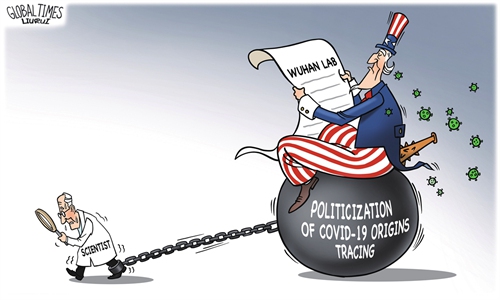Latest data shows Huanan Seafood Market not the origin of COVID virus: Chinese researchers

Huanan seafood market Photo:Xinhua
Amid waves of heated discussions about the coronavirus origins in the international community and China's recent release of a new analysis collected at the Wuhan Huanan Seafood market, Chinese researchers on Friday highlighted that the results of this COVID-19 surveillance within the market during the early stages of the COVID-19 outbreak confirmed that the market was merely one place where the coronavirus outbreak occurred but not the origin, and there is still lack of scientific data to conclude where the animal-to-human zoonotic transmission took place.
Chinese researchers also dismissed voices claiming China's lack of transparency in sharing origins-tracing data, clarifying that by adopting an open, transparent and responsible attitude, China has carried out a great deal of work, and shared the relevant data in a timely manner, while Chinese scientists have been making efforts to work closely with international scientists.
Researchers at the Chinese Center for Disease Control and Prevention (China CDC) have published the new version of the COVID-19 analysis collected at Wuhan's Huanan Seafood Market in the science journal Nature on April 5. Prior to the analysis' official publication, the data was shared on the Global Initiative in Sharing Avian Influenza Data (GISAID) database, but was allegedly deleted later, prompting widespread speculation.
In an interview with the Global Times on Friday, Liu Jun, a researcher from the China CDC who is also a member of the WHO-China joint expert team, clarified the facts, saying Chinese researchers and the GISAID database never deleted the data in question, and the data access links used for journal review have always been in existence.
"We submitted the first draft of the analysis paper to Nature in February 2022. During the process of submission and revision, experts from China CDC and other institutions uploaded the original data related to the paper on GISAID in accordance with the international practices of scientific paper publication, which was only used for journal review."
However, the data was released by GISAID staff before the publication of the paper and without the knowledge of our team, Liu noted.
The staff of our team called the GISAID platform over the situation. We were told that the release was caused by the malpractice of the staff of GISAID, thereupon, the platform shut down the data sharing but the data remained on the platform. Neither our team nor the platform deleted the data, and the data access links for journal review was always there, Liu added.
The China CDC expert also said that besides being officially published on Nature on April 5, all relevant original collected data has also been shared on four international and domestic database platforms.
According to the newly-released paper on Nature, 73 environmental samples out of 923 collected samples were found to be positive for COVID-19, and 457 samples were collected from 18 species of animals, but none of the animal samples tested positive.
Three live viruses were successfully isolated and the viruses from the market shared nucleotide identity of 99.99 percent to 100 percent with the human genomic sequences isolated among early infection cases, the paper showed.
Liu told the Global Times the genomic sequences results of environmental samples present at the seafood market show an abundance of human genome fragments. They also include some genes of common cold chain goods such as pigs, cows, chickens and ducks sold in the market, as well as a small number of gene fragments of animals such as mice and cats.
"The highest abundance of human genome fragments in the environmental samples indicates that COVID-19 contamination at the seafood market most likely came from the early human cases from the market," Liu noted.
Some experts have focused on the existence of gene sequences of animals that can be infected by COVID-19, but Liu told the Global Times that the current research data does not support the theory that there were animal infections in the Wuhan Huanan Seafood Market.
Even if animals were infected, it cannot be ruled out that human-to-animal reverse transmission occurred after human beings were infected with the virus, since the sampling period was in January, 2020, after the time when human cases were reported, Liu explained.
"The virus very likely entered the market through human infection or cold chain products, and the scientific basis for the so-called animal-to-human transmission is obviously insufficient."
Echoing Liu, Qian Zhaohui from the Institute of Medical Biology, Chinese Academy of Medical Sciences, told the Global Times that no direct evidence and analysis can prove the authentic origins of COVID-19, and the spread of the virus from bats to other animals and then from animals to humans is considered one of the possible origin hypotheses, but exactly where, when, and how the process occurred is not yet clear.
Data from the paper supported the idea that the Wuhan Huanan Seafood Market may have been just an amplifier of COVID-19 transmission, rather than a place where COVID-19 originated, Qian noted.
On Thursday, Maria Van Kerkhove, COVID-19 technical lead from the WHO, accused China of an "inexcusable" lack of transparency on COVID-19 origins in an editorial in the journal Science.
As a member of the WHO-China joint expert team, Liu refuted the claim, saying that Chinese scientists have been carrying out investigations and analysis to trace the origins of COVID-19 in an open, transparent and responsible manner, and have been working closely with scientists around the globe.
China has always been open to sharing all COVID-19-related data, including in the early stages when we conducted COVID-19 origins tracing research with the WHO in Wuhan, a member from the WHO-China joint COVID-19 origins study group told the Global Times on Friday on condition of anonymity. It would be a misconception for some international experts to say China lacks transparency on COVID-19 origins, said the expert.
Going back to previous outbreaks, including HIV and Ebola, the virus origins have always been a complex and difficult task that requires efforts of multiple countries and origins analysis of multiple regions, Qian noted.
The results of the phase one origins-tracing and the professionalism and reputation of the panel members and WHO should be respected, Qian said, calling for joint efforts from experts at home and abroad to solve this problem, which has never been a matter for an individual country.



